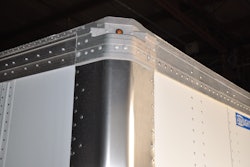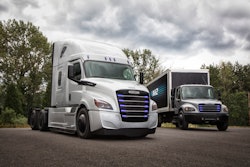When it comes to recycling, it’s hard to beat lead-acid batteries. It’s an impressive, closed-loop system where companies produce their batteries, get them to fleets and recycle old ones so they can be transformed into new batteries. The lead, the plastic and sulfuric acid can all be recycled.
“We usually get a one-for-one exchange,” said Interstate’s sustainability program manager Tod Lyons. “For every new battery our company sells, we usually get a battery in exchange otherwise you get a core charge. Scrap batteries that we receive are raw material for our new batteries.”
Battery manufacturers have been going green with lead for years. The high recyclability rate makes it more cost-effective.
“Just about every auto and truck battery out there is probably made with used lead,” Lyons said. “It’s such a sustainable material that’s been around for years. You’ve got around a 99 percent recycling rate when it comes to lead acid batteries. You can use that same lead over and over and over again.”
The plastic and the acid can also be recycled.
“The plastic covers and cases of spent batteries are crushed, melted and formed into pellets to make new battery covers and cases,” said Charles Giesige, Exide’s vice president of recycling operations.
“Spent acid is recycled for new-battery use, neutralized into water, or converted into sodium sulfate, an odorless powder used in laundry detergents, textiles and glass.”
Giesige said modern, closed-loop battery recycling keeps roughly 122 million batteries a year from landfills.
“Our internal recycling centers, along with our network of external recycling partners, ensure that the products are handled in compliance with all environmental regulations,” Giesige said. “By recycling batteries, fleets can contribute to the circular economy of lead batteries. Lead batteries have a 99.3 percent recycle rate, the highest of any consumer product in the U.S. Additionally, the industry reuses more than 80 percent recycled materials in new batteries. Exide uses 100 percent recycled secondary plastic in its batteries and is the only battery manufacturer to do so in the U.S.”
Battery recycling isn’t complicated. Often depending on fleet size, batteries can be arranged for pick-up or fleets can deliver them to a distribution center. Some fleets may benefit by delivering the batteries themselves.
“Delivery will get you a little bit more value, but we do have the ability to pick up,” Lyons said. “In most cases they’ll cut them a check right there on the spot based on whatever price per pound they offer. Lead is a commodity, so it is something that changes but not significantly.
“Lead is a little bit different than your other commodities like gold and silver, but it’s still a commodity and there is a market for it that’s impacted by supply and demand,” Lyons continued.
Depending on the arrangement, fleets may opt for a credit towards the purchase of new batteries. Battery suppliers like Interstate and Exide work with their customers to determine an ideal recycling program.
“We have a comprehensive logistics network that regularly handles the pick-up of spent batteries and the transport of these spent batteries to an appropriate recycling center,” Giesige said. “This agreement is typically part of any customer contract.”
Prior to delivery, take steps to stack batteries properly. According to Lyons, palletized batteries cannot be over three stacks high. Cardboard must separate each layer of batteries and also be placed on top of the stack prior to shrink-wrapping. A hazmat license is not required to haul used batteries Lyons said.
Be on the lookout for 12-volt lithium batteries which must be separated from lead-acid batteries that are bound for recycling. If a lithium battery is processed for recycling as a lead-acid battery, it can explode or catch fire.
“It’s either going to shut down the machinery for several days or potentially injure or even kill someone,” Lyons said. “That’s one of the campaigns we’re pushing right now to all of our distributorships as well as to all of our third parties we recycle batteries with is beware of the lithium batteries that look like lead batteries because you can’t ship those back beside it being illegal to ship them back on the same pallet they can’t go through the same process as a lead battery. Lithium batteries will explode. They can create fires. There are a lot of issues with lithium batteries.”
Regarding the recyclability of lithium batteries, Lyon said the value really isn’t there yet. Interstate recycles lithium and nickel metal hydride batteries found in power tools.
“The difference between that and a lead battery is that your lithium batteries right now will cost you to recycle because they’re not currently quite as sustainable as lead batteries,” Lyons said.
Time will tell if the growing EV segment, which now includes a few medium- and heavy-duty trucks, will continue to pursue lithium batteries.
“It depends on whether lithium’s going to be the chemistry of the future,” Lyons said. “There’s a real discussion as to whether lithium is really the value of what they’ve come out early to say. Certainly lithium batteries recharge a little quicker. They’re a lot lighter. They hold their charge a little bit longer, but the biggest thing is the recycling aspect.”
China-based BYD, the largest EV manufacturer in the world, said as much after announcing the opening of its EV battery recycling plant in Shanghai.
“Unfortunately, I’m sad to report that it’s not a very efficient process,” BYD’s electric truck senior sales manager for national fleets George Miller told an audience last year at ACT Expo in Long Beach. “Right now, they’re smelting these batteries and they’re getting out anywhere from 40 to 60 percent of the cobalt and the rest results in slag—a highly toxic output that is not very usable.”
Still, Miller explained that the value of cobalt is paying for the recycling process and that improvements in recycling methods continue to develop.











